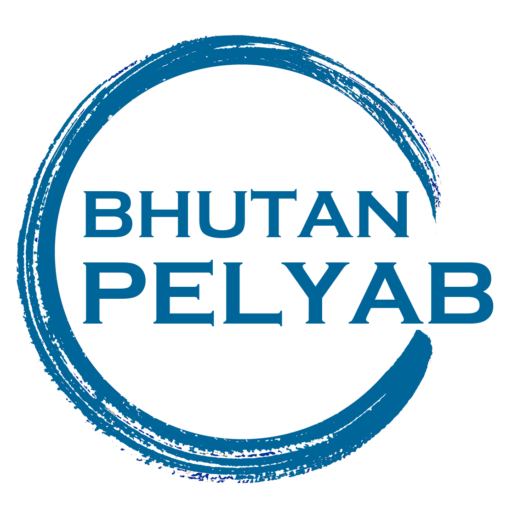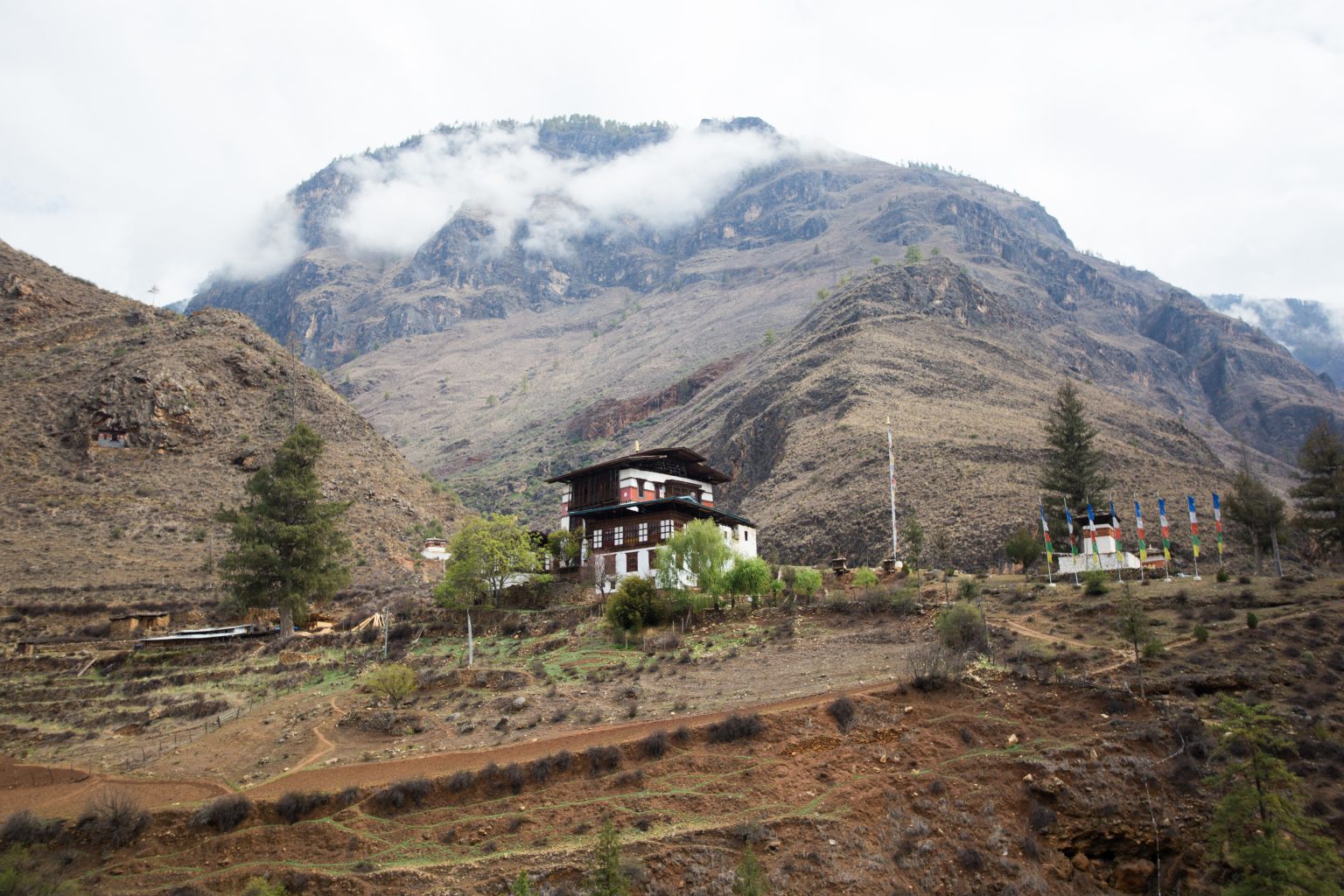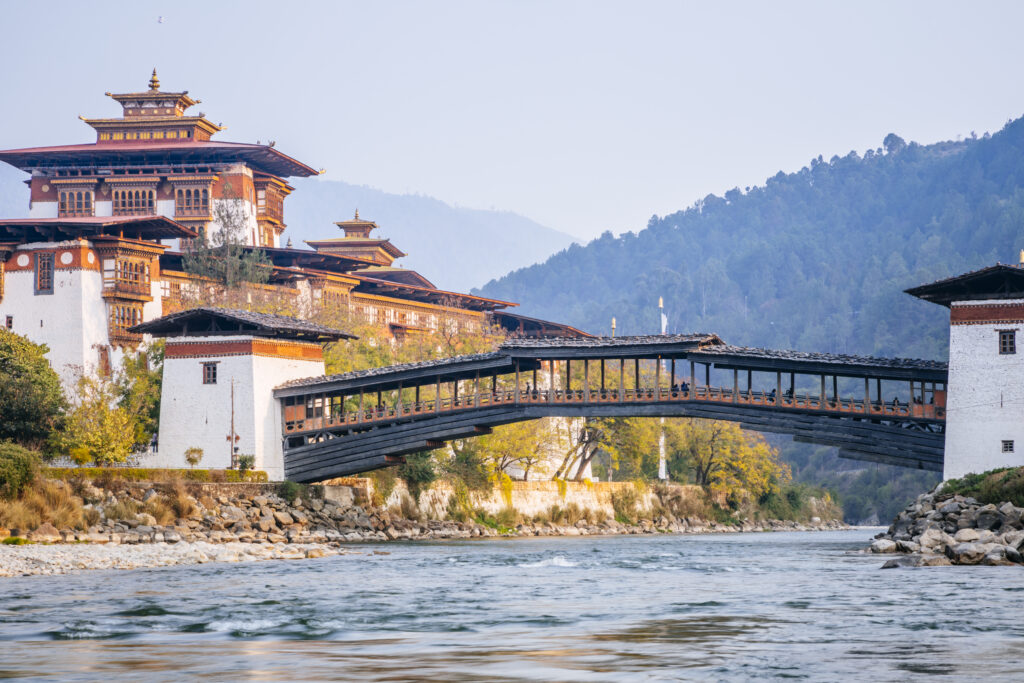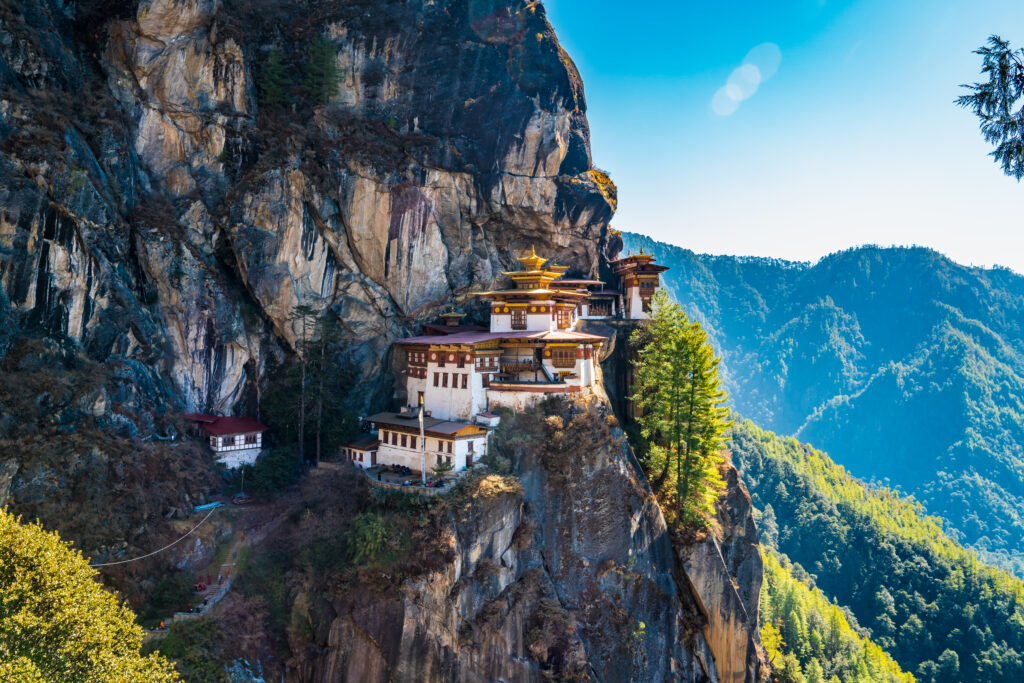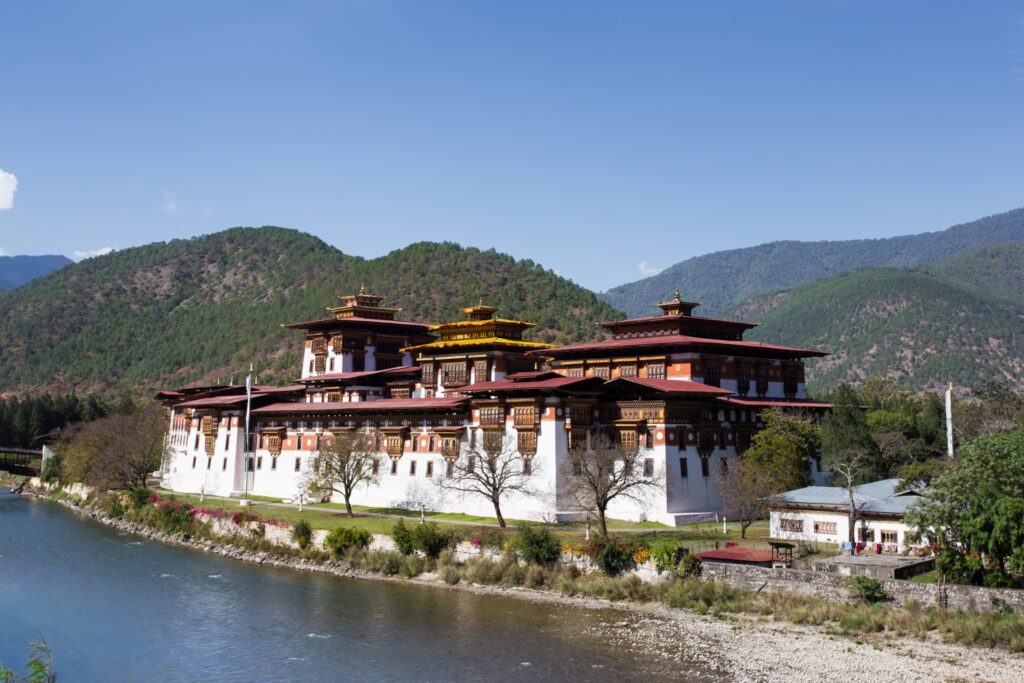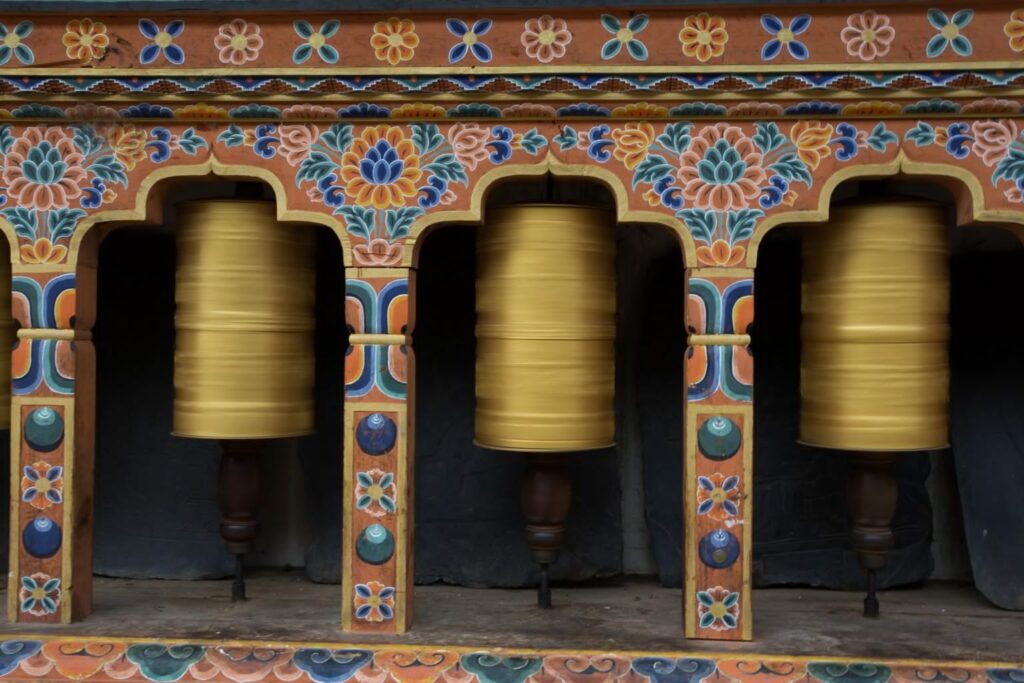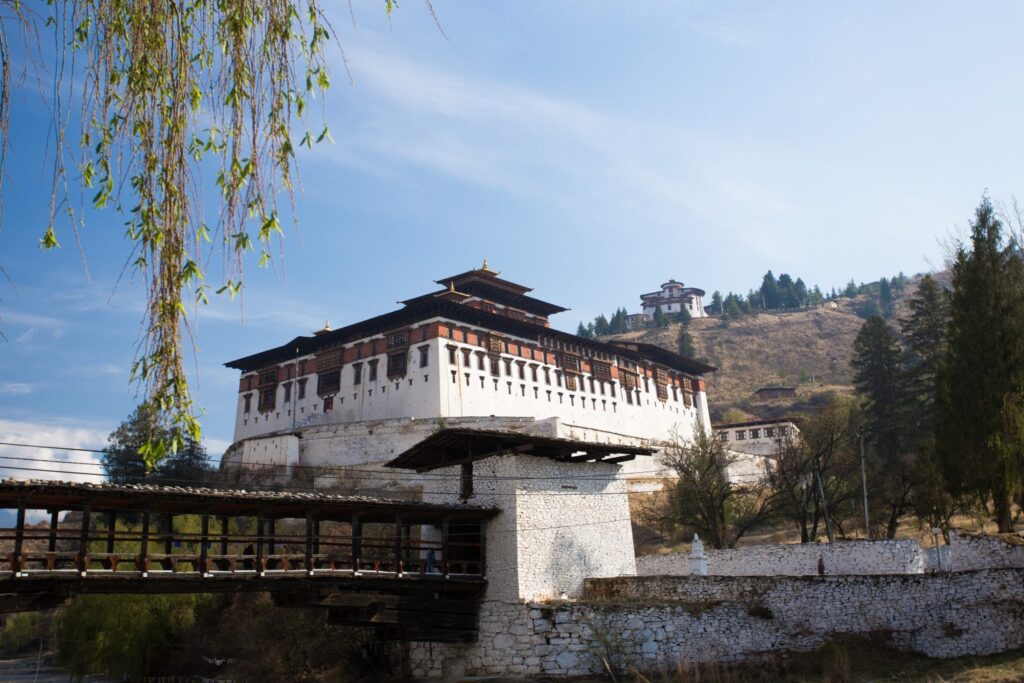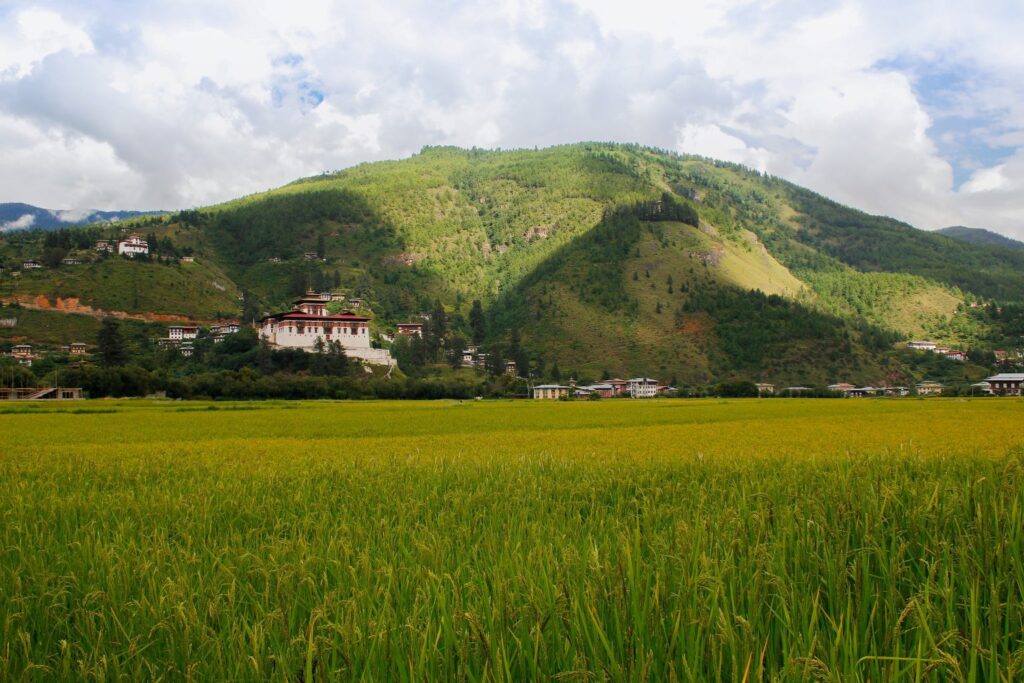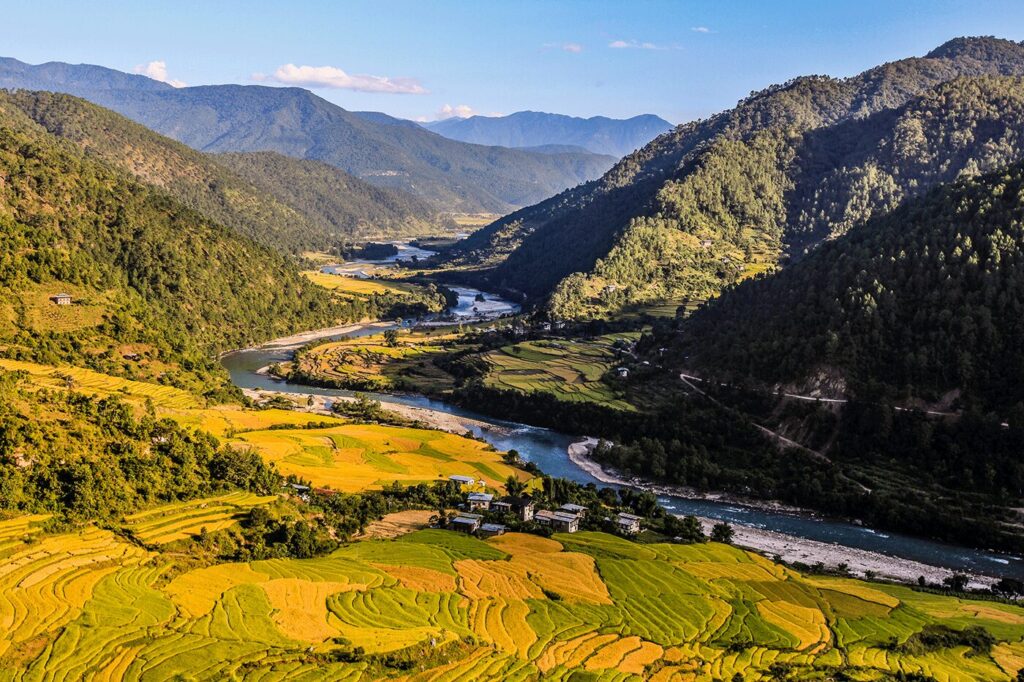Day 01: Arrive in Paro and travel to Thimphu
- Altitude in Thimphu: 2,400m
- Distance: 55km
- Estimated travel time: 1.30hrs
As the plane approaches Paro (2,300m) you will have a spectacular view of the Himalayan peaks from above. From the airport, we will drive to the capital of Bhutan – Thimphu. It is also the only capital city in the world that does not use traffic lights. While on the way, we will also pay a visit to Tachogang Lhakhang (Temple of The Excellent Horse). The famous temple is situated just across the main Paro-Thimphu highway.
Arriving in Thimphu, we will have a short break before travelling to the National Memorial Chorten, built in 1974. The imposing building was erected in memory of the late Third King, His Majesty Jigme Dorji Wangchuck and dedicated to world peace.
Later, you can make your own stamp – a unique souvenir for your loved ones at home at the General Post Office.
The next destination is Buddha Point (Buddha Dordenma Statue) – one of the largest statues in Bhutan and in the world. Standing at a height of 51.5m, the golden Buddha can be seen sitting on a gilded meditation hall. But more than that, there are 125,000 smaller Buddha statues placed inside the giant monument. Following the prophecy, the gigantic statue is believed to bestow blessings and happiness to the world.
We will then drive to Motithang – a north-western suburb of Thimphu for the Wangditse Nature hike (2,400m). This is an easy hike and only takes about 2 hours to conquer. The trail, which is around 2.5km for one way, will guide us through the beautiful forest of oaks, blue pines, and rhododendrons. Colorful prayer flags can be seen all along the hike. Stopping at Motithang Takin Preserve (Royal Takin Preserve), we can see Takin – Bhutan’s national animal with the body of a cow and the head of a goat. You will visit Druk Wangditse Lhakhang temple, one of the oldest temples in Thimphu, and considered an important heritage site of Bhutan. If you look back while we are on the trail, you will find an incredible view of the Samteling Palace, Tashichho Dzong, and the whole of Thimphu Valley.
You will stay overnight at the hotel in Thimphu.
Day 02: Discover Thimphu
Cheri Goemba is your first stop on the 2nd day. Established in 1620 at an altitude of 2,800m, this is Bhutan’s first monastery. The monastery’s founder, Ngawang Namgyal, is also the founder of the Bhutanese state. We will ascend about 400m and reach the site after 1 hour of hiking. The hike will lead through a forest of blue pines, firs, and rhododendron trees. Also, the sight of gorals (wild goats) on the nearby cliffs is visible during the hike.
If your trip is on a weekend, we can visit the farmer’s market to see all kinds of fruits, vegetables, meat, and even incense sold here from all over the country. Then you can explore the lively Thimphu town and learn about the local’s daily life when wandering between shops.
Bhutanese are proud of their unique heritage and arts and you will understand more about their unique culture when we go to the Folk Heritage Museum and the National Textile Museum. The heritage museum is designed as a rural house from the mid-19th century with rammed mud timber and household objects. And you will get to see the practice of thagzo – Bhutan’s art of weaving using different styles and materials at the National Textile Museum.
Later, we will head to the National Institute for Zorig Chusum, commonly known as the ‘Arts And Crafts School’ or the ‘Painting School’, where students learn and practice traditional arts of Bhutan. From embroidery, painting to statue-making, the craft demonstrations are a photographer’s dream. The skills and disciplines of the students are undeniably impressive!
Before returning to the hotel, we will visit Tashichho Dzong (Fortress of The Glorious Religion). First built in 1216 A.D, the dzong has gone through several reconstructions because of fire. Standing proudly next to the banks of Wang Chhu River, the dzong is well-known for its imposing white walls and surrounded with lovely gardens. The captivating scene of flag changing at 5pm in the dzong is not to be missed once you are here. The ceremony begins in the courtyard and ends outside in the front of the dzong.
Afterwards, we will go back and stay another night at the hotel in Thimphu.
Day 03: Thimphu to Gangtey
- Altitude in Gangtey: 2,900m
- Distance: 160km
- Estimated travel time: 6hrs
Today we will travel to Gangtey valley – one of the most charming destinations in Bhutan, otherwise called Phobjikha valley. We will stop to enjoy the view at Dochula pass (3,050m), which is located on the way to Gangtey. This pass is very famous for the stunning sight of 108 chortens that can be seen from here. The colossal mountains in the distance is the perfect backdrop for the chortens – a real eye-catching scene that is loved by both locals and travelers.
Apart from the chortens, there is the Druk Wangyal Lhakhang, initiated and completed in 2008. The temple was assembled to honour His Majesty the fourth Druk Gyalpo, Jigme Singye Wangchuck and to celebrate 100 years of monarchy in Bhutan.
On arrival in Gangtey, we will visit Gangtey Goemba or ‘Gangtey monastery’, which is located on a hill overlooking the entire valley. Constructed in 1613, it is the only Nyingmapa monastery in this region. From the monastery, look out and you will have the striking view of the Gangtey valley’s lush expanse. In the winter, the rare Black Necked Cranes migrate to the valley from the higher altitude plateaus of the Tibetan region.
You will stay overnight at the hotel in Gangtey.
Day 04: Gangtey to Punakha
- Altitude in Punakha: 1,300m
- Distance: 87km
- Estimated travel time: 3hrs
Gangtey Nature Trail, the hike that we will do today is very popular with travelers for the pleasant experience it offers when discovering the picturesque Phobjikha valley. En route, we will pass prairies, farmhouses and lush pine forests, descend to a valley viewpoint and finish the hike at the small Khewang Lhakhang (Khewang temple).
While you are here, we also suggest trying out archery, one of the most popular sport in Bhutan. They are practiced in almost every family. Your guide and driver will be happy to teach you the basic techniques.
Then we will visit the Black–necked Crane Visitor Centre, which is located close by. The centre focuses on sustainable ecotourism activities, environment education, and conservation programs in Phobjikha valley. The building’s location allows people to overlook the wetlands, which is the Black-necked crane’s habitat.
From here, we will go to Punakha, Bhutan’s old capital. On the way, there is the beautiful Chimi Lhakhang (Temple of Fertility), which can be reached after a short walk, about 25 minutes, across the hillock fields and farmlands of Lobesa Village. The single building site was built in 1499, and becomes very famous with the locals. Childless women go to the temple to pray and receive a wang (blessing or empowerment).
Overnight at the hotel in Punakha.
Day 05: Punakha sightseeing
After breakfast, we will visit Sangchhen Dorji Lhuendrup Lhakhang Nunnery. The striking temple plus nunnery perches on a ridge overlooking the scenic valleys of Punakha and Wangduephodrang. It houses a 14-foot main bronze statue of Avalokiteshvara (Chenrigzig chagtong chentong). This giant masterpiece is the handiwork of local Bhutanese artisans. Asides from that, the complex also consists of a permanent higher learning and meditation centre for nuns.
The next stop is the iconic Punakha Dzong (Palace of Happiness). Built in 1637, this is arguably the most beautiful in Bhutan and one of the most impressive constructions in the world. The edifice was the seat of the Bhutan government until the early 1950s. The scene of Punakha Dzong is especially captivating in spring, when dzong’s whitewashed walls become the perfect backdrop for the lilac-coloured jacaranda flowers, bringing a dreamy feeling to the whole picture.
Passing the dzong, we will go to see Pho Chhu suspension bridge – the longest of its kind in Bhutan. The 160m bridge is decorated with colourful prayer flags. From the bridge, you will have the splendid view of Punakha Dzong and the lush landscape of Pho Chhu valley.
After lunch, we will take a pleasant hike through exquisite rice fields and pine trees to Khamsum Yuelley Namgyal Chorten. The majestic chorten sits on a ridge above Punakha valley, and we will reach it after 1 hour of hiking. At an altitude of 1,500m, this remarkable chorten consists a pagoda-style stupa and various smaller pagodas surrounding it, making it a great example of the Bhutanese architecture. It is dedicated to bring peace and harmony to the world, and to pray for the long life of our beloved King. Because of its location on the ridge, from here you can look out to the alluring landscape of the valley. Enjoy the amazing view!
Tonight you will stay at the hotel in Punakha.
Day 06: Punakha to Paro
- Distance: 125km
- Estimated travel time: 4hrs
We will drive back to Paro in the morning.
Paro Rinpung Dzong (Fortress of The Heap of Jewels), the first destination in the afternoon, is the finest example of Bhutanese architecture. It is a complex of courtyards, temples, offices and an accommodating area surrounded by towering walls, and can be seen easily from any place in Paro valley. The dzong was erected in 1644, on the foundation of a monastery built by Guru Rinpoche. This is where the famous Paro Tsechu is held annually.
The next dzong that we will see is renowned for its unique structure, which resembles a conch shell – the National Museum of Bhutan (or Ta Dzong). It used to be a watchtower protecting the land of Paro during wartime. The building was constructed in 1652, and turned into Bhutan’s first museum in 1968. The museum houses the most impressive and extensive collections, from Bhutan’s thangkas, textiles, costumes to armours, jewellery and household objects.
The late afternoon, we will have a nice walk to sightsee Paro’s vibrant streets and market, and we will stay overnight at the hotel in Paro.
Day 07: Paro sightseeing
We will visit one of the most popular destinations for any Bhutan travelers in the morning – Taktsang Monastery, also known as Tiger’s Nest monastery. The sacred temple sits on a sheer cliff at an altitude of 3,120m. To get to the monastery, we will hike for about 2-3 hours. The trail is 4.5km one way, with an elevation gain of 900m.
As we hike, we will also take multiple stops so that you can enjoy the incredible view of Paro valley from above and also the pleasant feeling of walking through untouched, shady pine forests. No trip to Bhutan would be complete without a visit to this spectacular heritage site.
Moving on, we will travel to Kyichu Lhakhang – one of the oldest and most imposing temples in the country. It is believed that the temple was built in 659 by the Tibetan King Songtsen Gampo to pin down the left foot of a giant ogress who was stopping the spread of Buddhism in Tibet. The sight of elderly pilgrims constantly shuffling around the temple and spinning the prayer wheels makes this location one of the most enthralling places in Paro valley.
For the late afternoon, we will have a special dinner with a local family in a traditional farm house. Enjoy your time chatting and hanging out with the warmest people over authentic Bhutanese dishes!
A nice traditional hot stone bath after all the hiking is another excellent way to relax your body. Besides, you can check out some cool pubs in Paro, where they serve tasty snacks and local alcohol for your last night in Bhutan.
You will stay in Paro for the last night of the holiday.
Day 08: Depart Paro
After breakfast at the hotel, your guide will accompany you to the airport for flight to your onward destination. Tashi Delek (goodbye and good luck) and we hope to see you again!
